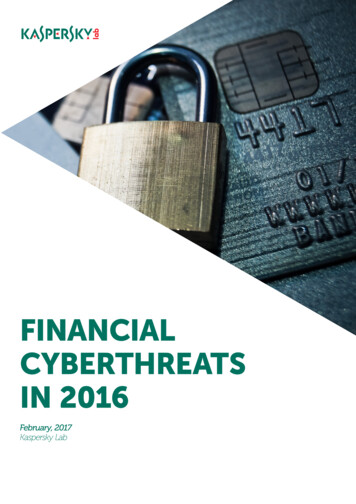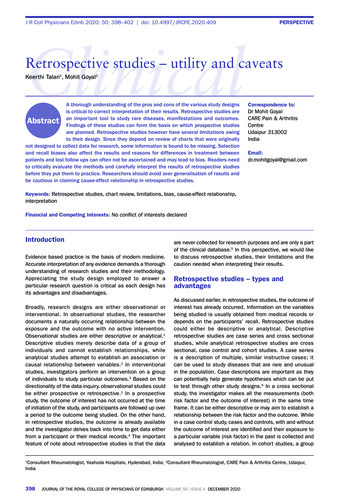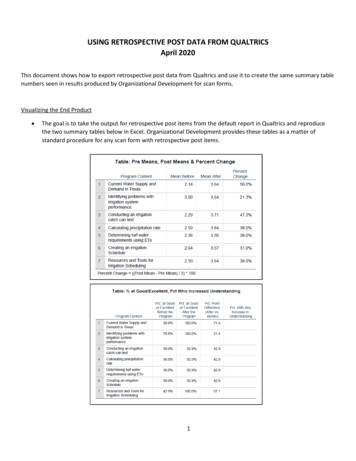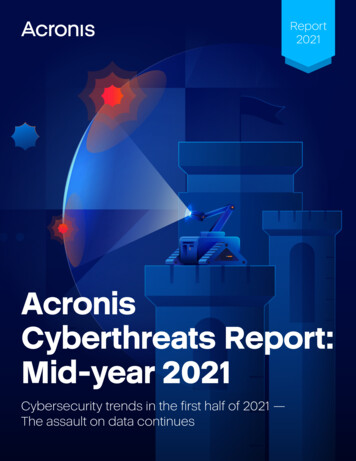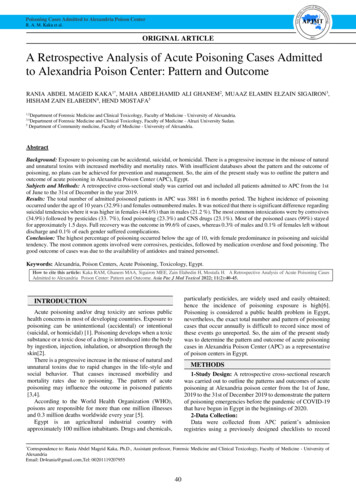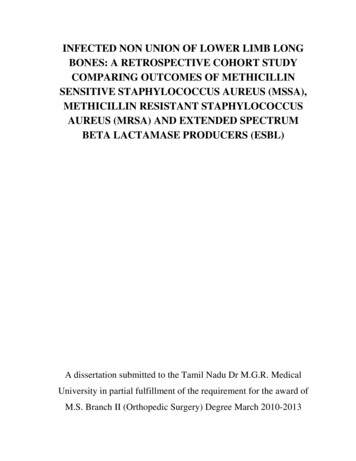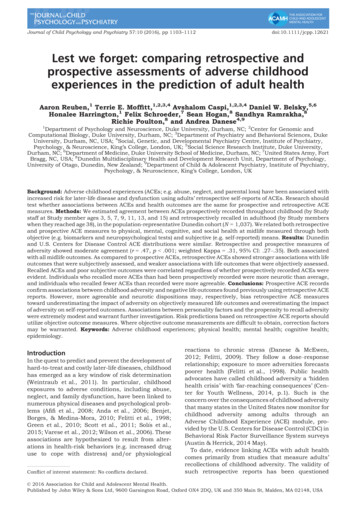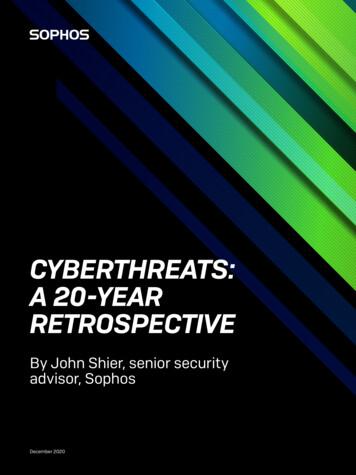
Transcription
CYBERTHREATS:A 20-YEARRETROSPECTIVEBy John Shier, senior securityadvisor, SophosDecember 2020
Cyberthreats: a 20-year retrospectiveIntroductionThe cyberthreats that shaped information securityIn security we spend a lot of time trying to decipher the future.Where’s the next technology breakthrough? What are cybercriminalsgoing to do next?Annual threat reports provide an opportunity to look back atsignificant events of the past 12 months and identify trends forfuture development, action and protection. Looking back in timea little further helps to provide context for how we arrived at ourcurrent situation and why some things are the way they are. A longview of history can point to subtle changes or seismic shifts withinan industry.Information security became a bona fide industry and professionaldiscipline at the beginning of the current millennium. What followsin this paper is a timeline of key threats and events from the past 20years that helped to shape our industry.Not all the events represent firsts, some represent significantmoments, but each of them correlates with a change in securitybehavior or protection.Some of these changes have persisted while others continue tobe re-evaluated and updated. The evolution of our industry canbe teased out of these moments and their impact will forever beencoded in the fabric of our discipline.December 20201
Cyberthreats: a 20-year retrospectiveThe cyberthreat timelineThe timeline is loosely categorized into three eras. Each era is defined by a threat or event thatproliferated throughout that time: The Worm Era, The Monetization Era and The Ransomware Era.2000–2004The Worm BagleAugust2001CodeRed 5–2012The Monetization Era2006Rx exploit PresentThe Ransomware 13CryptoLockerDecember 20202020APT tactics bythreat actorsJune2017NotPetya2
Cyberthreats: a 20-year retrospective2000-2004 - The Worm EraThis era saw the emergence of some of the most prolific worms the information securityworld has ever seen. Cumulatively, these worms infected tens of millions of systemsworldwide and cost over 100 billion in damages and remediation costs.They affected our business processes, changed the way we protected our networks andled Microsoft to launch Patch Tuesday. This can also be seen as the time when malwarebecame a mainstream media sensation. While there were worms that pre-dated thisperiod, and ones that came after, this was certainly their most impactful era.It started with loveILOVEYOU launched the worm era in 2000, using social engineering tricks that persisttoday. ILOVEYOU was notable for its rapid spread, broad reach and impact. It is estimatedthat the ILOVEYOU worm infected at least 10% of internet-connected hosts in a matter ofhours and caused up to 15 billion in damages and remediation costs.In addition to affecting consumers and some of the world’s largest companies, it causedthe shutdown of government email systems, including The Pentagon, CIA, and the BritishParliament.What made ILOVEYOU successful was a combination of social engineering and insecuredefaults in software.ILOVEYOU preyed on simple human curiosity to set off a chain reaction that spread likewildfire around the globe. The worm not only inspired the song “Email” by the British popduo the Pet Shop Boys, but also a movie starring Dean Cain titled “Subject: I Love you.”In response to ILOVEYOU and similar worms, Microsoft released an update to Outlook inJune 2000 with four key changes:Ì First, the patch prevented users from accessing unsafe attachments (i.e. executables)Ì Second, it warned users if a program tried to access their address bookÌ Third, users were also warned if a program tried to send mail on their behalfÌ And fourth, Outlook was moved from the “Internet zone” to the “Restricted zone”, whichdisabled most automatic scriptingA wave of wormsStarting in 2001 with the release of the CodeRed worm (July 2001), famously named afterthe flavor of Mountain Dew its discoverers were drinking at the time, the IT world was rockedby a series of worms: Code Red II (August 2001), Nimda (September 2001), SQL Slammer(January 2003), Blaster (August 2003), Welchia (August 2003), Sobig.F (August 2003),Sober (October 2003), Bagle (January 2004), MyDoom (January 2004), Netsky (February2004) and Sasser (April 2004).Unlike ILOVEYOU and pre-2000 worms, which targeted Microsoft Outlook, these wormstargeted operating system vulnerabilities, server applications and network infrastructure.Many of these worms abused buffer overflow vulnerabilities in various versions of Windows,or in applications such as Internet Information Services (IIS) or SQL Server. The intent wasnot always clear, but in some cases the impact was severe.December 20203
Cyberthreats: a 20-year retrospectiveCodeRed to NimdaCodeRed used a buffer overflow vulnerability in IIS to spread itself and deface websiteswith “HELLO! Welcome to http://www.worm.com! Hacked By Chinese!”. The worm was sopervasive that even Microsoft was impacted after failing to patch Hotmail servers.It was followed two weeks later by CodeRed II. This worm used a slightly modified bufferoverflow. In contrast to its namesake, CodeRed II focused largely on infecting internalnetwork targets and installing a back door on infected machines.Nimda, or “admin” spelled backwards, quickly surpassed the economic damage caused byprevious worms.Nimda was highly successful due to its use of five different infection vectors. Like manyprevious worms, it spread via email, but it could also spread by abusing open network shares,compromising web servers, and even leverage back doors left behind by previous worms.SlammerAfter a relatively quiet 15 months, Slammer set off another wave of worms in early 2003.It relied on another buffer overflow vulnerability and infected most of its victims within tenminutes of release.What made it so successful was its size, weighing in at only 376 bytes. Slammer used asingle UDP packet to deliver the worm. The targets were Microsoft database applications:SQL and MSDE.Routers started crashing under increased traffic load, which forced other routers toconstantly update their dynamic routing tables, causing further congestion and more routersto crash.Doubling its infections every 8.5 seconds, Slammer took down large swaths of the internetin only 15 minutes, including ATM networks, a 911 call center, and a nuclear power plant. Iremember sitting in a datacenter at the time furiously adding block rules for udp/1434 onas many firewalls as possible in an attempt to contain the worm as it tried to ravage ournetwork.Blaster to BagleThere was another lull until Blaster kicked off the final nine-month stretch of worms inAugust 2003. Blaster was created by reverse engineering a Microsoft patch a couple ofmonths before the first Patch Tuesday. The practice of reverse engineering patches wasbecoming so common that the day following Patch Tuesday became known as ExploitWednesday.Blaster exploited a buffer overflow vulnerability in the RPC service of Windows XP and 2000systems and launched a DDoS attack against “windowsupdate.com” if the day of the monthwas greater than 15 or the month was September or later.August 2003 also saw the release of two more worms. First there was Welchia, also knownas the “Nachi worm,” propagated using a similar RPC vulnerability as Blaster, but instead ofcausing damage it attempted to clean up Blaster infections.December 20204
Cyberthreats: a 20-year retrospectiveDespite its attempt at being a “helpful worm,” Welchia caused the shutdown of the US StateDepartment’s computer network for nine hours. The helpfulness of this worm was overshadowedby its aggressive scanning. Defenders had to prevent infected users from connecting to thenetwork because their systems would start looking for Blaster infections to repair.The second August worm was Sobig.F, which was both a worm and a trojan, and the fastestspreading worm to date.Sobig and its many variants infected computers through email attachments and subsequentlyused a built-in SMTP engine. It was also capable of deactivating many antivirus programs of theday.Sobig heralded two new phenomena: malware families and botnets-for-hire. After Sobig, itbecame more common to see multiple variants of the same malware. These new botnets gavespammers a convenient infrastructure to easily and anonymously send millions of unsolicitedemails every day.There were Sobig variants in the wild prior to August 2003 but the one that had the highestimpact was the record-setting Sobig.F. This variant led Microsoft to offer a 250,000 bounty forinformation leading to the arrest of its creator. On September 10, 2003, Sobig.F deactivated itself.Sobig was followed in October 2003 by the Sober family of worms. These were mass mailingworms that harvested address books and brought along their own SMTP engine to spread. Inaddition, Sober used fake web pages, pop-up ads and fake advertisements as a distributionmechanism.Like its predecessor, Sober was clearly designed to be used as a spamming botnet.During the monetization era that followed 2004, and after a stint promising free World Cuptickets, in May 2005 the Q variant of Sober began spreading links to German far-right websites toall PCs infected with the earlier P variant. According to SophosLabs, Sober accounted for 80% ofall malicious spam circulating the internet at the time.Then, in November 2005, Sober again shifted tactics and began posing as the FBI, CIA, or GermanBKA. The emails suggested that the recipient had visited illegal websites and needed to fill out aform explaining their actions. Later versions of the worm also started using celebrities as lures,namely Paris Hilton.Returning to the worm era, the next major event was Bagle, in January 2004. Bagle started life asa mass-mailing worm but eventually became a prolific spam spreading botnet. It was incrediblysuccessful due its aggressive development.It was clear that the author was constantly monitoring how antivirus companies were blockingtheir creation.For example, when the author noticed how antivirus vendors were blocking attachments, theyplaced the infected attachments in password protected archives, with the password in themessage body. When that stopped working, the author put the password in an image instead.Bagle was also one of the first threats to start using polymorphism. Botnets were becoming bigbusiness and competition was fierce.December 20205
Cyberthreats: a 20-year retrospectiveA fight to the finishA later variant of Bagle started an insult war with the Netsky worm’s author. As competition foravailable targets heated up, Bagle began replacing infections of Netsky with copies of itself.Thankfully, the onslaught of worms was nearing an end in 2004, but not before MyDoom struckand became the fastest spreading worm yet. A record that still stands today.Some initially suggested that the worm was written to defend Linux’s honor after a DDoSattack against SCO Group (which had made legal allegations against Linux OS), while othersalleged that it had been commissioned by spammers.In addition to spreading by email after pilfering address books, the worm also copied itselfto the download folder of peer-to-peer sharing software Kazaa, masquerading as one of thefollowing files: activation crack, icq2004-final, nuke2004, office crack, rootkitXP, strip-girl2.0bdcom patches, or winamp5.It was reported at the time that 25% of all emails sent in 2004 were infected with MyDoom anddamages were estimated at 38 billion.The Netsky family of worms was the first of two worms created by 18-year-old Germancomputer science student, Sven Jaschan. The worm is most famous for the insults beinglaunched at the authors of Bagle and MyDoom within its code.This back-and-forth skirmish led to a flurry of variants being released. In response to Bagle’sopening gambit, Netsky deleted competing worms, namely Bagle and MyDoom, from infectedcomputers.Sasser, the second Jaschan creation, was thankfully the last in a series of worms that hadforever changed the threat landscape.Sasser did not spread via email but rather exploited an LSASS vulnerability in Windows XP and2000 systems. Jaschan claimed that he created the worms to battle other, more destructiveworms. SophosLabs reported in August 2004 that both Sasser and Netsky were responsible for70% of all infections seen in the first half of that year.The impact of the worm eraThe early worms showed how readily people click on links in unsolicited attachments. Theyalso demonstrated the effectiveness of the “double-extension” trick.Unlike today, where most people use webmail through a browser, in the early years of themillennium most users, both at home and at work, relied on a full client to access email. Mostcomputers had Outlook (at work) or Outlook Express (at home) installed.The author of ILOVEYOU used a double extension on the payload (i.e. LOVE-LETTER-FOR-YOU.txt.vbs) that gave users a false sense of security. Windows has a default setting of suppressingdouble extensions for file types it knows. Therefore, users would see “LOVE-LETTER-FOR-YOU.txt” and think it was a harmless text file. To make matters worse, clicking on an attachment inOutlook (Express) in those days didn’t display the file, it ran it!Another notable impact is that in October 2003, Microsoft introduced Patch Tuesday, providinga structured and consistent approach to distributing patches.December 20206
Cyberthreats: a 20-year retrospectiveBefore this, patches were distributed ad-hoc or as part of service packs. Since patches to manyof the vulnerabilities exploited by the worms were already available before the worms hit, theprocess was clearly not effective.The ad-hoc patches were readily taken up by consumers, but enterprises were not preparedto constantly certify patches. They preferred the slower service pack model. Back then,the average time to patch a security vulnerability in an enterprise was about six months.Today, automatic patching is the norm and we hardly notice when many applications patchthemselves.There was also a deliberate effort to segregate networks as insurance against the next worm.Not only were firewalls being used to restrict inbound and outbound access to the internet, butthey were increasingly being used internally.This provided companies with choke points that could be easily closed in the event ofan outbreak. More attention was paid to which ports were open and which hosts couldcommunicate with each other.Email filtering matured during this era. As worm authors kept trying to outsmart email filteringproducts, email filtering vendors added more detection tricks to their products. Defendersbegan blocking all sorts of file types in earnest.And while email borne threats continued to proliferate, cybercriminals were already shiftingtheir focus toward the next era: making money.2005-2012 – The Monetization EraThis era saw the rise of cybercrime as a business. Prior to this, malware incidents were mostlyassociated with one of the following: curiosity, disruption, or notoriety.Building on a cyberthreat landscape shaped by the worms, most of the new threats weredesigned for profit but many were still too noisy.Spammers started aggressively pushing out all sorts of spam including luxury goods andpharmacy spam.There was a new marketplace opening up for cybercriminals of differing talents. Exploitmerchants found a niche within the evolving malware ecosystem. Their exploit kits helped drive“malvertising,” which took advantage of an increasingly connected world.Bulletproof hosting provided the infrastructure for all manner of cybercrime to flourish andproliferate like never before. Wherever there was the potential for financial gain, cybercriminalsexploited those opportunities.Cybercriminals, like their counterparts in the real world, got organized.December 20207
Cyberthreats: a 20-year retrospectiveAffiliate networks and pharmacy spamSpam had previously been a delivery mechanism for chain letters from an unwitting friend orrelative, or a way to spread worms, but now it found a way to monetize itself through onlinescams.As senior director of threat research at Sophos, Dmitry Samosseiko had written back in hisVB2009 paper, “The stores sell fake watches, fake antivirus software, fake pills and fake love –the webmasters get their commission, making thousands of dollars per day.” Pharmacy spamstarted appearing as a result of the proliferation of botnets-for-hire from the previous era.The business model then shifted to rely on hundreds of affiliate networks, known as“Partnerka” in Russian.These affiliates, who called themselves “webmasters,” drove traffic to online stores run bycyber kingpins. While the Partnerka offered diverse products, chief among them was onlinepharmacy spam. This included the infamous “Canadian Pharmacy” spammers.The online pharmacies provided a vast array of prescription medicines at discounted prices.The untimely death of Marcia Bergeron in 2006 marks the moment when these pharmacyscams went from merely financially motivated to criminally negligent.With the help of bulletproof hosts, the Partnerka and their affiliates made untold billions frompharmacy spam. Others took note and financially motivated cybercrime was here to stay.The Storm botnetOnce dubbed the world’s “most powerful supercomputer,” due to its size, the Storm botnetepitomized the monetization era.Storm was designed for stealth and profit. At its peak, estimates of the botnet’s size rangedfrom one million to 10 million infected computers. Storm deviated from its predecessors’playbook of noisy and aggressive to favor a more patient and silent approach.Notoriety wasn’t the goal; it was trying to amass as many infected hosts as possible. As theStorm worm extended its reach and assembled the Storm botnet, several key design decisionsensured its resilience.Notably, it kept a low profile, often sitting dormant for months at a time awaiting instructions.Different parts of the botnet were responsible for specific tasks. Instead of relying on a centralcommand-and-control (C2) infrastructure, Storm preferred a distributed peer-to-peer model.These features made it much more difficult for defenders to isolate and disable the botnet.Not only were the C2 servers distributed, but Storm also used fast-flux DNS and polymorphismto evade defenders.When it wasn’t busy infecting computers, Storm was capable of launching DDoS attacksagainst anti-spam sites (Spamhuas & 419eaters) and security researchers (Joe Stewart.) Manyof Storm’s features became standard for future botnets.ZeusFirst identified in July 2007, the Zeus/Zbot trojan and its many offspring grew into some of themost prolific threats we’ve ever seen.Zeus/Zbot is a “banking” trojan and these target users primarily through spam, phishing,advertising, drive-by-downloads, or social engineering. Zeus started life as a basic bankingtrojan, but in keeping with the era’s theme, quickly developed into a full feature crimeware kitand “Crimeware-as-a-Service” was born.December 20208
Cyberthreats: a 20-year retrospectiveZeus licenses started at 1,000, but the author offered customized versions at a higher fee,which included 24/7 support and were distributed through affiliates.The author of Zeus allegedly retired and sold the code to its competitor, SpyEye, in 2010.The source code for Zeus was leaked online in 2011, which enabled less technicalcybercriminals to learn from one of the most well-known malware kits to date. Leaked Zeuscode was allegedly responsible for a number of variants, including Citadel, Gameover Zeus,ICE-9, CIDEX, Ramnit, Dridex, Kronos, Tinba and Panda.Both Zeus and Gameover Zeus were implicated in spreading the ransomware, CryptoLocker.Its use was the subject of a multi-national fraud investigation that resulted in over 100arrests.The Conficker wormConficker’s appearance signaled the return of the super-spreading worm.First detected on November 21, 2008, Conficker rapidly infected millions of computersworldwide but did not result in much damage.Despite five years having passed since the introduction of Patch Tuesday, and the lessonsfrom past worms, Conficker still caught the world by surprise.Conficker propagated by exploiting a vulnerability in the Windows Server service, theinfamous MS08-067 (CVE-2008-4250) vulnerability - a number forever burned in mymemory. Microsoft issued an emergency out-of-band patch for this critical vulnerabilitynearly a month (October 23, 2008) before the Conficker outbreak, but many did not patchtheir systems.With estimates of up to 15 million infected hosts, Conficker infected indiscriminately,including the armed services of France, Britain and Germany.One notable feature that set Conficker apart was its use of the as-yet-unreleased MD6cryptographic hash function to protect its payload. With this and other tricks learned fromprevious malware, Conficker was considered one of the most advanced threats to date.Unpatched and infected systems still exist and detections for this threat are still showingup in telemetry. Aside from a later variant dropping a spambot and scareware, we still don’tknow the worm’s true purpose.StuxnetStuxnet, believed to be the world’s costliest cyberattack to develop, was a digital weapontargeting a physical system.Stuxnet was allegedly developed by the NSA’s Tailored Access Operations group and Israel’sUnit 8200 as an alternative to a traditional kinetic military strike. Originally used againstindustrial control systems in Iran’s nuclear enrichment centrifuges at the Natanz facility,Stuxnet found its way into the wild and began infecting non-Iranian computers.While the Stuxnet attack achieved its specific goal of damaging nuclear centrifuges, it failedto stop Iran’s nuclear enrichment program. Two additional advanced persistent threats(APTs), Duqu (2011) and Flame (2012,) were a direct result of Stuxnet’s development.December 20209
Cyberthreats: a 20-year retrospectiveFurther, the unintended release into the wild of Stuxnet handed cybercriminals at least four zeroday vulnerabilities that could be used to attack general targets.Stuxnet’s enduring legacy is that it permanently opened the door to nation-states’ use of digitalsolutions in analog conflicts. We would see this repeated with the Shamoon (2012) attack onSaudi Aramco and the BlackEnergy 3 (2014) attack on the Ukrainian power grid.The story of Stuxnet was featured in the 2016 documentary “Zero Days.”The Blackhole exploit kitBlackhole wasn’t the first exploit kit (EK). That honor belongs to MPack from 2006. However, theemergence of the Blackhole exploit kit (BHEK) in 2010 provided another way for cybercriminals tocoordinate and monetize their specialties.Exploit kits were the glue that held together different parts of the cybercrime ecosystem,including spammers, exploit merchants, traffic aggregators, website hackers and malwareauthors.Blackhole was so prolific in its heyday that many defenders had to separate their threat stats by“Blackhole” and “not-Blackhole.”Exploit kits prefer drive-by downloads as their infection vector. The BHEK drove the undergroundexploit market to produce more vulnerabilities than could be consumed by any one platform.Many vulnerabilities focused on some of the most deployed and unpatched applications: Java,Adobe Reader, Shockwave and Flash.The payloads dropped by the BHEK included ransomware’s precursor, FakeAV, rootkits and Zeus.So successful was the BHEK and its subscription business model that when its author, Dmitry“Paunch” Fedotov, was arrested in late 2013 many of the copy-cat exploit kits started jockeyingfor position in the void left by Blackhole’s absence.In 2015, the Angler EK took top spot by specializing in zero-day vulnerabilities.Malicious advertisingFollowing earlier attacks against prominent sites, malicious advertising (“malvertising”) alsofound its stride during this era. Aided and abetted by Blackhole and other exploit kits, malvertisingincreased 2.5-fold in 2011 and an estimated 10 billion ad impressions were compromised bymalvertising in 2012.Malvertising campaigns attacked some of the web’s largest sites, driving home the message thatthere was no such thing as a “safe site.”By 2011, online advertising generated over 30 billion in revenues in the US alone. This wasdriven by an ever-growing number of users surfing the internet, providing an ever-increasing poolof targets for cybercriminals.Key to malvertising’s success was the infiltration of the advertising ecosystem. This couldbe accomplished by compromising the ad networks or real-time bidding services, posing aslegitimate advertising firms representing bogus brands, or as bogus firms representing legitimatebrands.December 202010
Cyberthreats: a 20-year retrospectiveWhatever the ruse, malvertising was used to deliver any number of payloads, includingspyware, adware, cryptominers and eventually, ransomware. Although Windows was theprimary target, the platform agnostic nature of malvertising meant that it could also infectMacs, Chromebooks and mobile devices.The impact of the monetization eraThe events of this era led to an improvement in email filtering due to unprecedented levels ofspam and the growing threat of phishing.Exploit kits and malvertising led to further filtering of web content.The increased threat from drive-by downloads while browsing online, and the abundance ofvulnerabilities for many popular applications that made exploit kits and malvertising possible,also drove the adoption of application control technologies and patch management software.We started seeing browsers auto updating and sandboxing themselves and the gradualdeprecation of some of the most vulnerable applications. Although for some applications (suchas Adobe Flash), it wasn’t fast enough.In response to the Conficker worm, in 2009 Microsoft made two important changes to the wayits operating systems handled USB drives. First, AutoPlay no longer supported the AutoRunfunctionality for non-optical removable media. Second, Microsoft added a notification in thepop-up dialogue to indicate a program was running from external media. These are the kindsof slow gradual changes that we see from time-to-time that increase both awareness andsecurity.Exploits kits and malvertising also resulted in exponential growth of the market forvulnerabilities during this era. It didn’t help that nation-state-sponsored attackers werereleasing zero-days into the wild.Malvertising eroded whatever trust was left in online advertising. At first, they were merelya nuisance, with all their popping over and popping under, but by now they were dangerous.Ad blockers proliferated. Consumers, advertisers and content creators have been locked in apitched battle over fair access to content ever since.We also started seeing unprecedented industry cooperation. To combat Conficker, an industryworking group was formed in February 2009. The clear and present threat of malvertising alsoelicited the forming of the Anti-Malvertising Task Force.Cooperation between the information security industry, law enforcement and paymentprocessors had a profound impact on cybercriminals’ money-making operations, such as thatimplemented by the Reveton trojan.In the early part of the monetization era, payment processors started banning FakeAVoperators from accepting credit card payments. Coupled with greater awareness andprotection, criminals moved to “police lockers.”Distributed by the Zeus-derived Citadel trojan, the Reveton trojan began to spread in 2012. Themalware would lock the user’s session posing as a local law enforcement agency and accusevictims of illegal activity such as downloading unlicensed software, movies or music, andcollecting child sexual abuse material.December 202011
Cyberthreats: a 20-year retrospectiveThe malware demanded a fine be paid in the form of prepaid cash services, such as Green DotMoneyPak, Ukash and Paysafe. Cracking down on these payment alternatives the criminalswere left with only one option: cryptocurrency.2013-Present – The Ransomware EraRansomware is not the only defining event during this era, but it has certainly had the greatestimpact.There’s an argument to be made that we should have seen it coming. After all, the idea wasn’tnew. The first recognized ransomware threat was the AIDS trojan of 1989. Extortion had beenthe motive behind many DDoS campaigns. Police lockers were heading in the same directionbut weren’t devastating enough.Modern ransomware found the right blend of technology and urgency. While all other threatscontinue to exist, nothing has come close to rivaling ransomware’s destructive force.Damage estimates from ransomware attacks are in the trillions of dollars. It has exposed manyweaknesses in IT defenses, spawned new technologies and new industries and, unfortunately, ithas also had a profound impact on healthcare providers and other critical industries.Moreover, many of today’s cyberattacks ultimately end with the release of ransomware and, likeexploit kits, it has provided a nitro-fueled boost to an already thriving cybercrime ecosystem.The Snowden leaksThe Snowden leaks revealed to the world the extent to which our privacy was under attack.Not only were cybercriminals in the game but, as many had suspected, so were our owngovernments. Edward Snowden’s stolen material dwarfed all previous leaks, including ChelseaManning’s incendiary leaked material from 2010.The Snowden documents were immediately divisive. The reactions by government, consumersand the technology industry, which
Cyberthreats: a 20-year retrospective December 2020 2 The cyberthreat timeline The timeline is loosely categorized into three eras. Each era is defined by a threat or event that
